#we also helped with the school gardens and we brought some thyme and sunflowers at home
Explore tagged Tumblr posts
Text
today felt so long and yet it's only 2 pm
#sunflower rambles#it was really nice tho i had a nice time finally#i went to school since a lot of the teachers wanted me there#wasn't in class though i was with my mentoring teacher; mostly outside and chatting#we also helped with the school gardens and we brought some thyme and sunflowers at home#man i wish everyday was like this..............i'm so tired now#i'm forced to go to the funeral in 2 days too i don't know how i'll cope with that#my mood will SURELY drop#and im supposed to finish AND start commissions#i. i think im gonna explode
7 notes
·
View notes
Text
My Syracuse Pollinator Garden - Year 2
Hi everyone! I’m sure a lot of us are facing stress during these troubling times and so as I’ve mentioned before, gardening is an excellent way to take your mind off of current events, de-stress, reflect and connect yourself with nature while remaining in the safety of your own property. Last year, when I moved into my Syracuse apartment (technically a room in my landlady’s house; I’m here for grad school), I was granted permission to start a pollinator garden. I am a pollinator ecologist slash conservation biologist so I bring some expertise with me here. I say this because I always encourage anyone who sees this and is curious about doing it yourself to come and ask me questions! I highly recommend you check out last year’s post which thoroughly goes over 1) the principles of gardening for pollinators and wildlife, 2) resources to help you learn more and get started, 3) what plants I have in this garden, and 4) how it progressed over the course of the summer in 2019. Unfortunately, because of fieldwork and coursework I had trouble keeping up with it regularly so I think I missed a fall installment. I intend to be more thorough this year. Quite a lot has already happened, and I will review it the best I can and from this point forward, attempt monthly updates.
I also want to mention that I’ve learned a lot since last year too - better ways of doing things, since I’m not a landscaper. Such as, you don’t have to break your back digging up turfgrass for hours on end. Instead, you can smother it for three months with old newspapers and get rid of it that way. It’s also important to note that the way I have my garden laid out is not ideal for a pollinator garden, it doesn’t follow every recommended principle. That’s because I had limitations and conditions under which I had to work, given that it’s not my own land and I had limited funds. But any effort is better than nothing, so don’t think that just because it’s not perfect, it’s not worth it. It is! You can always build, change, or improve upon it later.
In the second year of a new garden with perennials, you can expect a lot more vibrant growth - the plants have established root systems and can put more energy into above-ground growth and flower production. Thus, I was thrilled to see my plants growing more vigorously than before!
MARCH
Here in central New York, March was still freezing, wet, and snowy. But, by the end of the month, the garden was starting to show signs of life, sending up the first shoots of hardy native perennials.
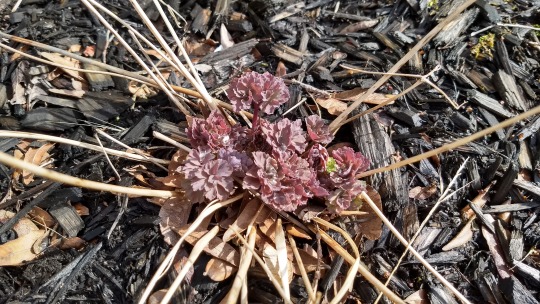
In particular, the Jacob’s ladder already had quite a lot of new growth, with the nodding onion and yarrow close behind. In my herb garden, the chives had erupted with force from the leaf litter. The yard was still messy, with dead stems and fallen leaves blanketing much of the ground. My landlady insists I clean these, but if it’s your choice, leave the leaf litter around where you can. It’s important habitat for invertebrates and returns nutrients to the soil as it decomposes.
APRIL
The world was beginning to wake up. I had cold-stratified hundreds of seeds of native plants I’d collected last fall, and it was time to take them out of the fridge. The wild cucumber (Echinocystis lobata) had already sprouted, so I planted them in pots. The rest, I put in a seed starter tray.

Next, within the first few days of April, male hornfaced bees (Osmia cornifrons) started emerging in multitudes from my bee hotel. These are a non-native, but naturalized, species of mason bee common in suburbia and they are the most frequent users of bee hotels in the northeast. I watched as they dug through the mud cap on their natal nests, peeking out with fresh eyes at the sun for the very first time. I felt like a proud parent. (You can see more pictures here)

At the same time, male Dunning’s mining bees (Andrena dunningi) were patrolling the new nest sites of females, dug in the soil between the stones laid down near the front door.
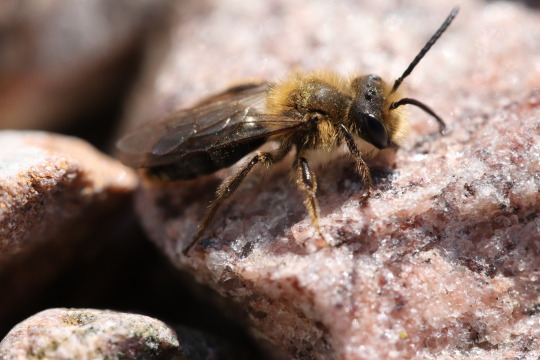
There wasn’t much for these bees to forage on yet, mainly the wild violets that grow each year on the lawn and my landlady’s invasive vinca. But many more of my perennials had started to come up, and I decided it was time to cut the dead stems.

It is best to cut dead stems back in April or so if you’re in a northern clime; the purpose of this is to offer nesting places for stem-nesting bees, which will start flying in April and May. Don’t cut them to the ground, give them several inches. Leaving stems through the winter also allows birds to forage on the seedheads.
Towards the end of April, despite several more snowstorms, the barren strawberry began to bloom.

I also saw the emergence of the female hornfaced bees, with males pursuing close behind. It is advised that you discard a bee hotel after the bees have emerged, or else they will try to nest in it again, which can lead to high mortality rates, as an old structure harbors parasites and is generally dirty.
MAY
May was a month of excitement. Given that I have been at home almost every day instead of being on campus, I was able to closely monitor the progress of the garden, apart from a week spent at home for my birthday. The dandelions dotted the yard, attracting gynes of common eastern bumblebees (Bombus impatiens) and the first honeybees (not native, need I remind you).

Alongside the dandelions was ground-ivy, which sent up stalks of purple flowers also used by the bumblebees. Almost all my plants had sprouted at this point.

My wild cucumber, which is a vine, had grown so rapidly that I couldn’t give it support fast enough, and eventually it decided to wind itself around my drapes. I brought one home as a gift for the parents, and placed the other two outside and snaked them around the front banister. However, despite my best efforts, only two other seeds from the hundreds I cold-stratified sprouted. A disappointment for sure; I was hoping to have swamp milkweed in the yard. But, there’s a chance for the wild hibiscus! Alas, with new growth comes deer, traipsing through the yard each night intent on nibbling my natives. They hit the columbine heavy this year as they did last year, and that stunted its growth and prevented it from flowering on time. I managed to protect it by putting a recycling bin over it each night. From the 7th to the 17th, I went home and visited a local native nursery.

There, I picked up a new plant for the garden - scarlet bee balm, Monarda didyma. I already have bee balm (M. fistulosa), but this species blooms red and is attractive to hummingbirds.
When I got back to Syracuse, I was astounded to find how quickly everything had shot up.
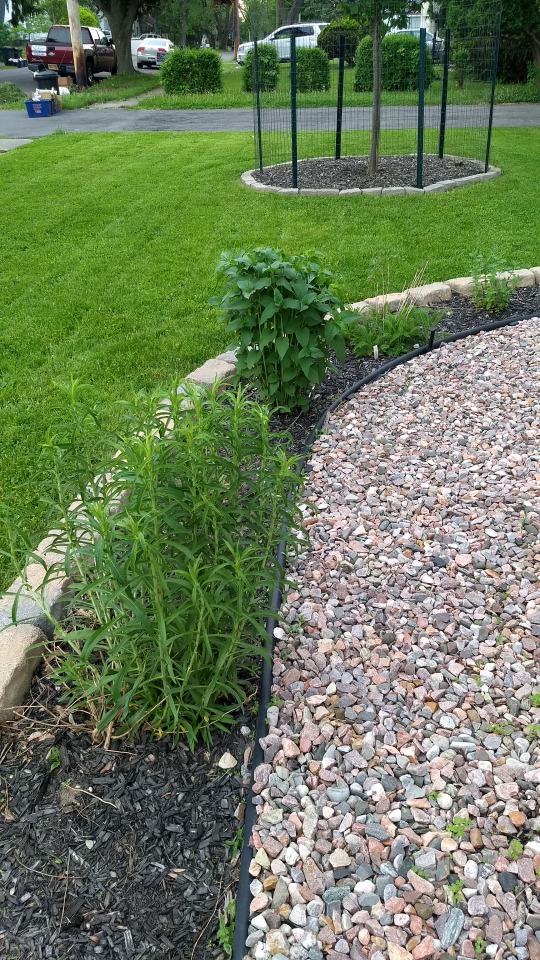
Among new blooms were the Jacob’s Ladder, woodland stonecrop, and finally, the wild columbine. The chives and thyme began to flower as well.


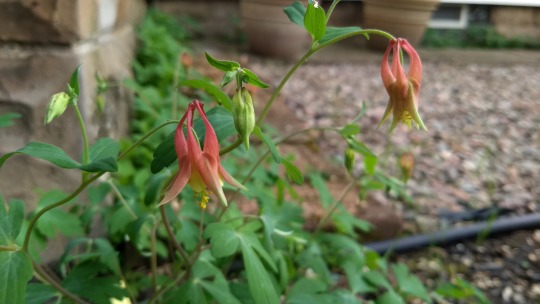
The milkweeds were one of the last to come up, being late to break dormancy. But once they did, they grew like lightning, gaining a foot in a week.

I planted my row of annuals (cosmos and sunflowers) along the walkway, and added beans to my herb garden. The dill and basil sprouted and once they get a bit bigger I’ll transplant them outside.
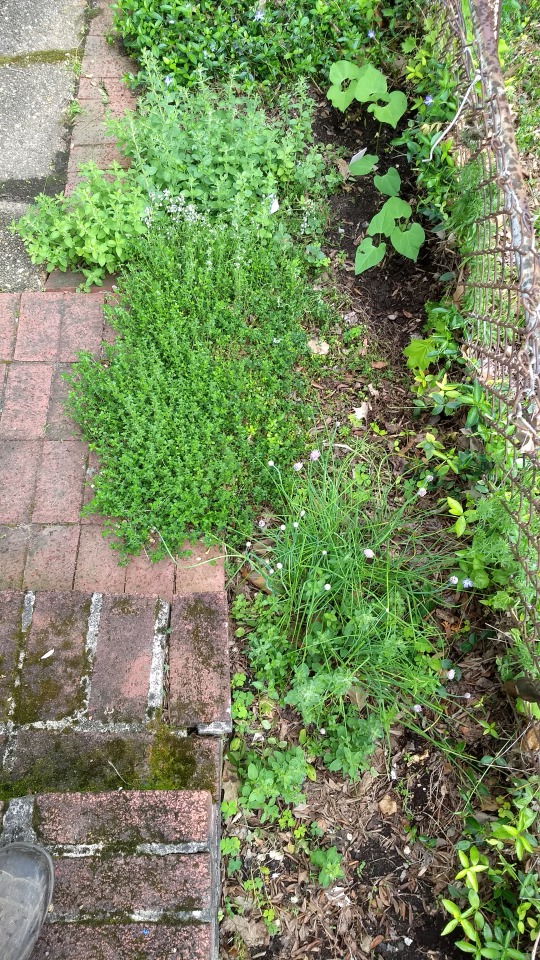
Then, in late May, I visited my advisor’s farm, and he gave me two new plants for the garden, from his own land - Golden Alexanders (Zizia aurea), which is a lovely yellow-flowered member of the carrot family which blooms in spring, and the classic purple coneflower (Echinacea purpurea). They transplanted well.

Honestly, everything is doing better than I could have hoped. What were ungainly spaces between the plants last year are starting to fill in as they grow more vigorously - the single-stalked milkweed I put in last May is now 17 stalks, and I see seedlings of the biennial brown-eyed susans coming up all around it in a three foot radius. Even the purple prairie clover which was eaten to the ground by rabbits last summer has miraculously returned. The only thing I am still waiting on is the bottlebrush grass, which remains dormant. It’s a warm-season grass, so I hope as we get sustained high temperatures in June, it will come back! But its seedlings too are popping up all around the beds.
And this sums up spring! It has become cold again for the week, but that won’t halt the growth once it’s started. The New England aster is almost half as tall as me, and my black raspberry has flowered and hopefully will produce a small handful for me to enjoy!
Check back in late June for another update on the garden!
18 notes
·
View notes